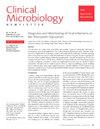Clostridium botulinum disorders associated with speech processes and verbal communication: a comprehensive and documented review
Q3 Medicine
引用次数: 0
Abstract
Clostridium botulinum is an anaerobic, spore-forming bacterium which produces eight different antigenic exotoxins (A, B, C1, C2, D, E, F, and G) and among them A, B, E and F are special for humans. This toxin has heavy (H) and light (L) chains, the light chain acts on Snap-25 protein in neuromuscular junction and cause paralysis in skeletal muscles by disabling SNARE proteins and then inhibiting the release of acetylcholine, then, causing diplopia, dysarthria, dysphagia. Among all clinical signs, dysarthria is characterized by difficulty in speech which is caused by paralysis of muscles of larynx, pharynx and oral cavity which are related to phonation and then speech. Dysarthria is a sign of botulism that appears in different kinds of botulism, but especially in wound botulism. Early administration of antitoxin play a vital role in the treatment, but the efficacy of antibiotic therapy has not been completely understood, because it can either improve or worsen the situation, also supportive treatments such as mechanical ventilation, physiotherapy and gastric lavage may help to reduce the incubation period.
肉毒杆菌疾病与语言过程和语言交流相关:一项全面的文献综述
肉毒杆菌是一种厌氧孢子形成细菌,产生8种不同的抗原外毒素(A、B、C1、C2、D、E、F和G),其中A、B、E和F是人类特有的。该毒素具有重(H)链和轻(L)链,轻链作用于神经肌肉连接处的Snap-25蛋白,通过使SNARE蛋白失能,抑制乙酰胆碱的释放,引起骨骼肌麻痹,引起复视、构音障碍、吞咽困难。在所有的临床症状中,构音障碍的特点是言语困难,是由与发声、言语相关的喉部、咽部和口腔肌肉麻痹引起的。构音障碍是肉毒杆菌中毒的一个标志,出现在不同种类的肉毒杆菌中毒中,尤其是伤口肉毒杆菌中毒。抗毒素的早期治疗在治疗中起着至关重要的作用,但抗生素治疗的疗效尚未完全了解,因为它可以改善或恶化情况,此外,机械通气、物理治疗和洗胃等支持性治疗可能有助于缩短潜伏期。
本文章由计算机程序翻译,如有差异,请以英文原文为准。
求助全文
约1分钟内获得全文
求助全文
来源期刊

Clinical Microbiology Newsletter
Medicine-Infectious Diseases
CiteScore
2.20
自引率
0.00%
发文量
35
审稿时长
53 days
期刊介绍:
Highly respected for its ability to keep pace with advances in this fast moving field, Clinical Microbiology Newsletter has quickly become a “benchmark” for anyone in the lab. Twice a month the newsletter reports on changes that affect your work, ranging from articles on new diagnostic techniques, to surveys of how readers handle blood cultures, to editorials questioning common procedures and suggesting new ones.
 求助内容:
求助内容: 应助结果提醒方式:
应助结果提醒方式:


